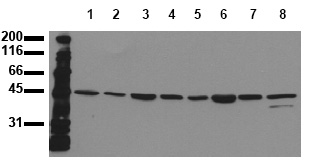MEK7 (MAP2K7) (incl. pos. control) Mouse Monoclonal Antibody [Clone ID: 10F7]
CAT#: AM00096PU-N
MEK7 (MAP2K7) (incl. pos. control) mouse monoclonal antibody, clone 10F7, Purified
Specifications
| Product Data | |
| Clone Name | 10F7 |
| Applications | ELISA, IF, IHC, WB |
| Recommended Dilution | ELISA: 0.1 µg/ml. Western Blot: 0.5 µg/ml for HRPO/ECL detection. Recommended blocking buffer: Casein/Tween 20 based blocking and blot incubation buffer. Included Positive Control: Cell lysate from Untreated SW480 cells. Immunocytochemistry. Immunohistochemistry on Frozen Sections. |
| Reactivities | Canine, Human, Mouse, Rat |
| Host | Mouse |
| Isotype | IgG1 |
| Clonality | Monoclonal |
| Immunogen | Synthetic peptide conjugated to KLH. Epitope: N-Terminus. |
| Specificity | This antibody specifically recognizes the N-terminus of MKK7. |
| Formulation | 1 ml 2 x PBS containing 0.09% Sodium Azide, PEG and Sucrose State: Purified State: Lyophilized purified IgG fraction from Serum-free Cell Culture Supernatant |
| Reconstitution Method | Restore with 1 ml H2O (15 min, RT). |
| Purification | Size Exclusion Chromatography |
| Storage | Store lyophilized at 2-8°C for 6 months or at -20°C long term. After reconstitution store the antibody undiluted at 2-8°C for one month or (in aliquots) at -20°C long term. Avoid repeated freezing and thawing. |
| Stability | Shelf life: one year from despatch. |
| Predicted Protein Size | 45 kDa |
| Database Link | |
| Background | The stress response of mammalian cells results in activation of kinases of the SAPK1 and SAPK2 families. The SAP kinases are specifically activated by dual phosphorylation of a conserved T-X-Y motif by MAP kinase kinases (MKK). The 3 isoforms of the SAPK1 family (SAPK1α/jnk2; SAPK1β/jnk3; SAPK1γ/jnk1) are synergistically activated by phosphorylation of the threonine residue by MKK7 and the tyrosine residue by MKK4. |
| Synonyms | MAPK/ERK kinase 7, JNK-activating kinase 2, c-Jun N-terminal kinase kinase 2, MAPKK 7, NKK2, MEK7, MKK7, MAP kinase kinase 7 |
| Note | Protocol: Positive Control Cell lysate from untreated SW480 cells Format: Lyophilized cell lysate from serum starved SW480 cells. Reconstitution: Restore by addition of 200 μl H2O. After complete solubilization add 200 μl 2x SDSPAGE sample buffer, mix and incubate at 90°C for 5 min. Applications: The positive control cell lysate is recommended for immunoblot applications. 20 µl of positive control cell lysate correspond to ca. 20.000 cells. Use 20 μl / lane (mini gel) for HRPO/ECL detection of the target proteins. Note: The lyophilized cell lysates contain SDS and are not recommended for applications with native proteins such as immunoprecipitation. Storage: In aliquots at -20°C. Avoid repeated freezing and thawing. |
| Reference Data | |
Documents
| Product Manuals |
| FAQs |
{0} Product Review(s)
0 Product Review(s)
Submit review
Be the first one to submit a review
Product Citations
*Delivery time may vary from web posted schedule. Occasional delays may occur due to unforeseen
complexities in the preparation of your product. International customers may expect an additional 1-2 weeks
in shipping.






























































































































































































































































 Germany
Germany
 Japan
Japan
 United Kingdom
United Kingdom
 China
China



